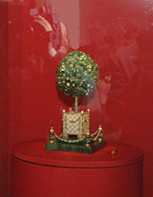Bay Tree (Fabergé egg)
| Bay Tree Fabergé egg | |
|---|---|
 | |
| Year delivered | 1911 |
| Customer | Tsar Nicholas II, as a gift for Dowager Empress Maria Feodorovna |
| Current owner | |
| Individual or institution | The Link of Times Foundation, Russia |
| Year of acquisition | 2004 |
| Design and materials | |
| Materials used | Gold, green and white enamel, nephrite, diamonds, rubies, amethysts, citrines, pearls and white onyx |
| Height | 27.3 cm when closed, 30 cm when opened |
| Surprise | Feathered songbird |
The Bay tree egg (also known as the Orange tree egg) is a jewelled carved nephrite and enameled Easter egg made under the supervision of the Russian jeweller Peter Carl Fabergé in 1911,[1] for Nicholas II of Russia, who presented the egg to his mother, the Dowager Empress Maria Feodorovna on April 12, 1911.[2]
Surprise
Turning a tiny lever disguised as a fruit, hidden among the leaves of the bay tree, activates the hinged circular top of the tree and a feathered songbird rises and flaps its wings, turns its head, opens its beak and sings.[1]
History
Based on an 18th-century French mechanical orange tree,[3] it was incorrectly labeled as an orange tree for some time, but was confirmed as a bay tree after the original invoice from Fabergé was examined. Fabergé charged 12,800 rubles for the egg.[1]
In 1917 the egg was confiscated by the Russian Provisional Government and moved from the Anichkov Palace to the Kremlin.[1] It was sold to Emanuel Snowman of the jewellers Wartski around 1927.[1] Passing through different owners, it was sold to Malcolm Forbes in 1965 for $35,000, equivalent to $212,634 at the time of the 2004 sale of the Forbes Collection to Viktor Vekselberg. Vekselberg purchased some nine Imperial eggs, as part of the collection, for almost $100 million [4]
The egg is now part of the Victor Vekselberg Collection, owned by The Link of Times Foundation and housed in the Fabergé Museum in Saint Petersburg, Russia.